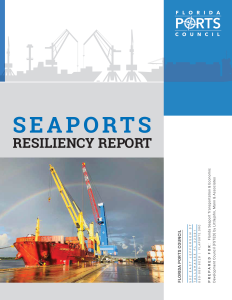Seaports Resiliency Report
What Does It Mean For A Seaport To Be Resilient?
Seaports are not stand-alone facilities, but rather, are integral components of national, regional, and local economies. Seaport resiliency is the ability to coordinate freight movement through ports in times of severe stress on existing infrastructure and operations, including damage to port facilities, highway, rail, or waterway routes leading into and out of the port. In many ways, Florida seaports are leading the nation in resiliency planning and investments to become even more resilient in the face of sea level rise and natural disasters.
What are the potential impacts of sea level rise, and when and how should seaports plan for these anticipated sea level increases? These are complex issues, made all the more challenging due to the significant cost and service-life of maritime infrastructure, including ship berths and cargo handling equipment.
Florida is prepared to evaluate and plan for sea level rise through its master planning process, ongoing commitment to protecting the environment, and predictive modeling. Through the use of tidal gauges, LiDAR and Physical Oceanographic Real-time Systems (PORTS), Florida ports such as Port Everglades and JAXPORT are evaluating the optimization and historical storm surges surrounding the ports. This is taken into account for master planning updates, and while designing new bulkheads. Currently, Florida seaports must have cargo handling equipment that can accommodate approximate 2.5 feet of tidal fluctuations. This is within the range of anticipated sea level increases in 2050, so there is no compelling urgency to update equipment or infrastructure prior to the normal replacement cycle. Wharfs and berths have an approximate lifespan of 20-50 years and a height of 7.5-12.5 feet above water. All port cargo handling equipment is designed based on current ship size, which changes with each new generation of vessel.
Florida seaports are already making significant efforts to minimize the extent and duration of impacts from natural disasters. As a peninsular state, Florida seaports and their surrounding communities face logistical challenges beyond the direct impact of natural disasters. Coastal transportation infrastructure in Florida is especially vulnerable to disruption, and seaports should carefully consider steps to become more resilient. The financial and social impacts associated with temporary seaport closures, reduced cargo capacity, and infrastructure damage can be devastating, and adequate planning and preparation are paramount.
An evaluation of strategies and best practices is provided as a resource for seaports to ensure they can minimize potential threats and maximize opportunities to protect supply chains following natural disasters. The most critical priority for planning is the need to ensure channel and navigable waters are cleared for access to the port post-event. This requires coordination between the seaport, U.S. Coast Guard, U.S. Army Corps of Engineers, and the National Oceanic and Atmospheric Administration prior to and following the storm event. Florida seaports have proactively worked with state and local governments and utility providers to ensure electrical infrastructure leading to seaports is hardened by replacing wooden power poles with concrete poles that can withstand Category 5 winds. Additionally, Florida seaports benefit their surrounding community following a natural disaster if they are properly integrated into resiliency planning efforts at the local or regional level.
The issue of fuel supply and distribution takes on additional importance during hurricane season in Florida. The vital supply lines at fuel terminals located on seaports in Canaveral, Everglades, JAXPORT, Manatee and Tampa are put under enormous constraints before and after any hurricane impact. Florida seaports continue to seek ways to improve the distribution of fuel at these terminals. Florida ports are currently working with the petroleum industry, petroleum marketers/retailers, the U.S. Coast Guard, and state emergency management officials to identify any necessary infrastructure investments. They continue to seek better ways to communicate the status of and access to these fuel terminals after the U.S. Coast Guard has deemed them safe to function.
This report serves as a resource for all seaports as they evaluate methods of improvement, taking advantage of lessons learned from Florida over the years. Resilient seaports, properly integrated into the preparedness plans of the surrounding community, can be a tremendous resource before, during and after a major storm event. Their actions will largely determine the timing and ability to process cargo in an efficient, cost-effective manner and be in a position to support the needs of impacted constituents. This potential role presents opportunities for seaports to expand the range of services provided. Florida seaports view resiliency planning as a long-term investment and ever improving process that requires continuous reappraisal.

